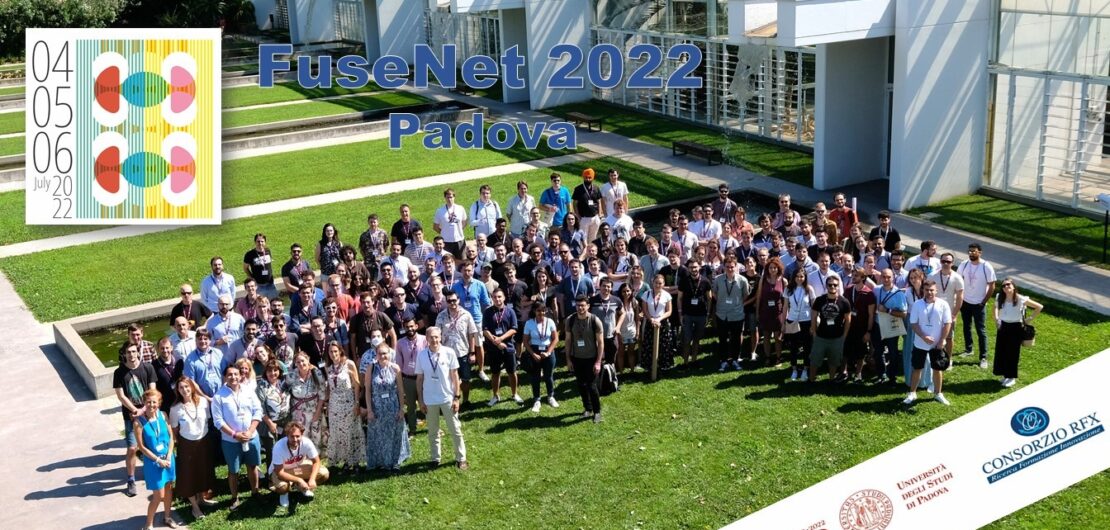 News
News
FuseNet PhD Event 2022 4-6 July Padova (Italy)
On 4th-6th July, the FuseNet PhD Event 2022 took place in Padua, Italy. 131 PhD students coming from 23 countries and 44 different institutes and universities, including the University of Tuscia in Viterbo, participated and animated the FuseNet PhD Event 2022. After two years, it finally took place in a live format again, in the amazing venues of University and Orto Botanico of Padua. The event was hosted by the University of Padua and Consorzio RFX and it was the place where European fusion PhD students meet and interact with affirmed international researchers in the field of Nuclear Fusion, aiming to strengthen and expand the fusion research network.
University of Tuscia was present at the event with 8 PhD students, who presented their research activities during poster sessions over the 3 days.
During three days, participants had the possibility to listen interesting talks of different important personalities in the fusion research as: Elena Righi (Head of Unit Euratom, European Commission), Piero Martin (professor at University of Padova), Elena de la Luna (researcher at LNF CIEMAT), Simone Peruzzo (Head of Technology and Engineering at Consorzio RFX), Gianluigi Serianni (researcher at Neutral Beam Test Facility), and Chiara Bustreo (project leader of the EUROfusion Socio Economic Studies). Three guided tours were organized to explore some important places of Padova: Palazzo Bo, Orto Botanico and Consorzio RFX. Furthermore, different oral sessions and poster sessions animated the days and permitted the students to know a lot about different topics related to the Nuclear Fusion world. To conclude social dinners entertained participants.
Different topics were exposed during the poster sessions from University of Tuscia. A brief presentation is reported.
- A work concerning the conceptual design of the mirrors of the multi beam transmission line of the Electron Cyclotron Heating system of the Divertor Tokamak Test Facility (DTT) was presented. In particular different coupled thermal and structural finite element (FE) simulations were carried out to study some first proposals of mirror design, comparing different structures and materials.
- A work concerning thermo-structural coupled analyses of the DTT vacuum vessel in multiple machine operating states was presented. The design was verified against the principle nuclear standards and design changes have been proposed according to the results of such verifications.
- A work concerning the conceptual design of the vacuum system for DTT was presented, focusing on three main sub-systems: divertor, vacuum vessel and cryostat. In particular the systems operations were explained, and estimations of regeneration and evacuation times were carried out and a first layout shown.
- A work concerning the Spherical Tokamak ST40, owned by Tokamak Energy Ltd, was presented. In particular the definition of the structural behaviour of the ST40 Inner Vacuum Chamber under the action of electromagnetic loads from plasma fast “upper vertical displacement event” scenario was investigated. The considered loads were obtained from the electromagnetic analysis of the device and interpolated on the structural model. Indeed, the study represents the final phase of the proposed procedure, and it verifies the compatibility for non-conventional low aspect ratio tokamaks.
- A work concerning the structural assessment of tokamak components under thermal and electro-magnetic loads emerging during normal and off-normal operations (e.g., plasma disruptions) was presented. An approach aimed at 3D detailed evaluation of the electro-magnetic loads experienced by the tokamak structures both in normal and off-normal conditions was proposed, developed and successfully applied to DEMO, DTT and ST40.
- A work concerning the description of the neutral model in the GBS simulation code was presented. The simulations are able to reproduce neutral-plasma interactions in the 3D turbulent fluid simulations made with GBS. They show the first simulations obtained with neutrals in a TCV-like scenario, a study of the density shoulder formation, along with the latest work made to simulate also the molecular neutral dynamics.
Finally, a work about the first wall sacrificial limiters inside the vacuum vessel that represents the last protection resource to prevent the reactor wall from excessive damage was presented. The integration of W-lattices in the architecture of such components can allow to meet their conflictual requirements: through a prompt vapour shielding formation, these can ensure effective thermal decoupling between plasma and heat sink during disruptions and provide effective exhaust of the nominal thermal load during stationary operation.